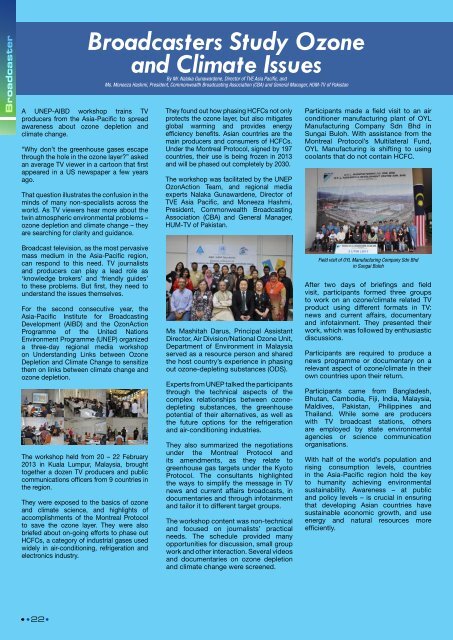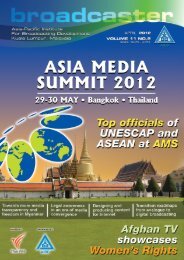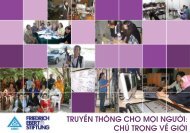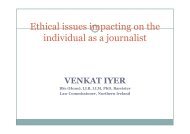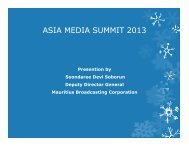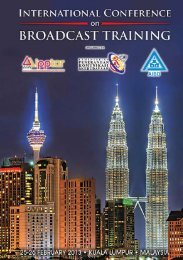Co-productions
Broadcaster 042013.pdf - AIBD
Broadcaster 042013.pdf - AIBD
- No tags were found...
Create successful ePaper yourself
Turn your PDF publications into a flip-book with our unique Google optimized e-Paper software.
Broadcaster<br />
A UNEP-AIBD workshop trains TV<br />
producers from the Asia-Pacific to spread<br />
awareness about ozone depletion and<br />
climate change.<br />
“Why don’t the greenhouse gases escape<br />
through the hole in the ozone layer?” asked<br />
an average TV viewer in a cartoon that first<br />
appeared in a US newspaper a few years<br />
ago.<br />
That question illustrates the confusion in the<br />
minds of many non-specialists across the<br />
world. As TV viewers hear more about the<br />
twin atmospheric environmental problems –<br />
ozone depletion and climate change – they<br />
are searching for clarity and guidance.<br />
Broadcasters Study Ozone<br />
and Climate Issues<br />
By Mr. Nalaka Gunawardene, Director of TVE Asia Pacific, and<br />
Ms. Moneeza Hashmi, President, <strong>Co</strong>mmonwealth Broadcasting Association (CBA) and General Manager, HUM-TV of Pakistan<br />
They found out how phasing HCFCs not only<br />
protects the ozone layer, but also mitigates<br />
global warming and provides energy<br />
efficiency benefits. Asian countries are the<br />
main producers and consumers of HCFCs.<br />
Under the Montreal Protocol, signed by 197<br />
countries, their use is being frozen in 2013<br />
and will be phased out completely by 2030.<br />
The workshop was facilitated by the UNEP<br />
OzonAction Team, and regional media<br />
experts Nalaka Gunawardene, Director of<br />
TVE Asia Pacific, and Moneeza Hashmi,<br />
President, <strong>Co</strong>mmonwealth Broadcasting<br />
Association (CBA) and General Manager,<br />
HUM-TV of Pakistan.<br />
Participants made a field visit to an air<br />
conditioner manufacturing plant of OYL<br />
Manufacturing <strong>Co</strong>mpany Sdn Bhd in<br />
Sungai Buloh. With assistance from the<br />
Montreal Protocol’s Multilateral Fund,<br />
OYL Manufacturing is shifting to using<br />
coolants that do not contain HCFC.<br />
Broadcast television, as the most pervasive<br />
mass medium in the Asia-Pacific region,<br />
can respond to this need. TV journalists<br />
and producers can play a lead role as<br />
‘knowledge brokers’ and ‘friendly guides’<br />
to these problems. But first, they need to<br />
understand the issues themselves.<br />
For the second consecutive year, the<br />
Asia-Pacific Institute for Broadcasting<br />
Development (AIBD) and the OzonAction<br />
Programme of the United Nations<br />
Environment Programme (UNEP) organized<br />
a three-day regional media workshop<br />
on Understanding Links between Ozone<br />
Depletion and Climate Change to sensitize<br />
them on links between climate change and<br />
ozone depletion.<br />
The workshop held from 20 – 22 February<br />
2013 in Kuala Lumpur, Malaysia, brought<br />
together a dozen TV producers and public<br />
communications officers from 9 countries in<br />
the region.<br />
They were exposed to the basics of ozone<br />
and climate science, and highlights of<br />
accomplishments of the Montreal Protocol<br />
to save the ozone layer. They were also<br />
briefed about on-going efforts to phase out<br />
HCFCs, a category of industrial gases used<br />
widely in air-conditioning, refrigeration and<br />
electronics industry.<br />
Ms Mashitah Darus, Principal Assistant<br />
Director, Air Division/National Ozone Unit,<br />
Department of Environment in Malaysia<br />
served as a resource person and shared<br />
the host country’s experience in phasing<br />
out ozone-depleting substances (ODS).<br />
Experts from UNEP talked the participants<br />
through the technical aspects of the<br />
complex relationships between ozonedepleting<br />
substances, the greenhouse<br />
potential of their alternatives, as well as<br />
the future options for the refrigeration<br />
and air-conditioning industries.<br />
They also summarized the negotiations<br />
under the Montreal Protocol and<br />
its amendments, as they relate to<br />
greenhouse gas targets under the Kyoto<br />
Protocol. The consultants highlighted<br />
the ways to simplify the message in TV<br />
news and current affairs broadcasts, in<br />
documentaries and through infotainment<br />
and tailor it to different target groups.<br />
The workshop content was non-technical<br />
and focused on journalists’ practical<br />
needs. The schedule provided many<br />
opportunities for discussion, small group<br />
work and other interaction. Several videos<br />
and documentaries on ozone depletion<br />
and climate change were screened.<br />
Field visit of OYL Manufacturing <strong>Co</strong>mpany Sdn Bhd<br />
in Sungai Buloh<br />
After two days of briefings and field<br />
visit, participants formed three groups<br />
to work on an ozone/climate related TV<br />
product using different formats in TV:<br />
news and current affairs, documentary<br />
and infotainment. They presented their<br />
work, which was followed by enthusiastic<br />
discussions.<br />
Participants are required to produce a<br />
news programme or documentary on a<br />
relevant aspect of ozone/climate in their<br />
own countries upon their return.<br />
Participants came from Bangladesh,<br />
Bhutan, Cambodia, Fiji, India, Malaysia,<br />
Maldives, Pakistan, Philippines and<br />
Thailand. While some are producers<br />
with TV broadcast stations, others<br />
are employed by state environmental<br />
agencies or science communication<br />
organisations.<br />
With half of the world’s population and<br />
rising consumption levels, countries<br />
in the Asia-Pacific region hold the key<br />
to humanity achieving environmental<br />
sustainability. Awareness – at public<br />
and policy levels – is crucial in ensuring<br />
that developing Asian countries have<br />
sustainable economic growth, and use<br />
energy and natural resources more<br />
efficiently.<br />
22


